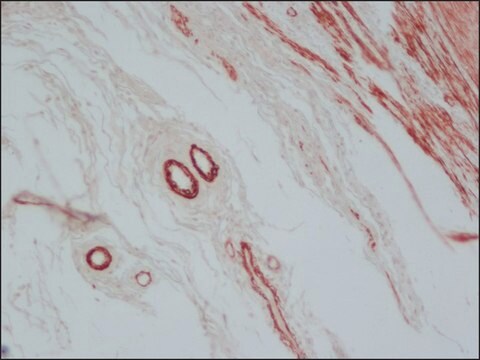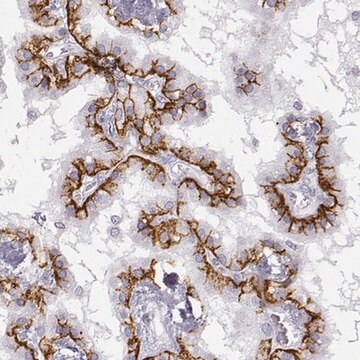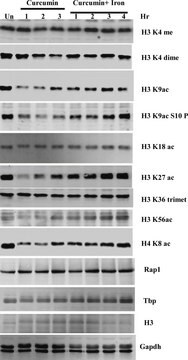L9536
Anti-Leptin Receptor antibody produced in goat
affinity isolated antibody, lyophilized powder
Sign Into View Organizational & Contract Pricing
All Photos(1)
About This Item
Recommended Products
biological source
goat
Quality Level
conjugate
unconjugated
antibody form
affinity isolated antibody
antibody product type
primary antibodies
clone
polyclonal
form
lyophilized powder
species reactivity
mouse
technique(s)
flow cytometry: suitable
immunohistochemistry (frozen sections): suitable
western blot: suitable
UniProt accession no.
storage temp.
−20°C
target post-translational modification
unmodified
Gene Information
mouse ... Lepr(16847)
Immunogen
recombinant mouse leptin receptor expressed in NS0 cells.
Biochem/physiol Actions
Leptin is a hormone secreted by adipocytes and regulates energy homeostasis, inflammation and neuroendocrine processes, synaptic formation and memory condensation. The physiological effects of leptin are mediated by leptin receptors, ObR and LepR. Leptin is the key regulator of obesity and acts directly on neuronal networks to regulate feeding, metabolism, gastric mobility and energy homeostasis. The pathways that mediate the effect of leptin are JAK/STAT, PI3K and JNK.
Physical form
Lyophilized from a 0.2 μm filtered solution in phosphate buffered saline with 5% trehalose.
Disclaimer
Unless otherwise stated in our catalog or other company documentation accompanying the product(s), our products are intended for research use only and are not to be used for any other purpose, which includes but is not limited to, unauthorized commercial uses, in vitro diagnostic uses, ex vivo or in vivo therapeutic uses or any type of consumption or application to humans or animals.
Not finding the right product?
Try our Product Selector Tool.
Storage Class
11 - Combustible Solids
wgk_germany
WGK 3
flash_point_f
Not applicable
flash_point_c
Not applicable
ppe
Eyeshields, Gloves, type N95 (US)
Choose from one of the most recent versions:
Already Own This Product?
Find documentation for the products that you have recently purchased in the Document Library.
Rola Hammoud et al.
Molecular nutrition & food research, 64(9), e1901178-e1901178 (2020-02-29)
High-folic-acid diets during pregnancy result in obesity in the offspring, associated with altered DNA-methylation of hypothalamic food intake neurons. Like folic acid, the methyl-donor choline modulates foetal brain development, but its long-term programing effects on energy regulation remain undefined. This
A G Leary et al.
Blood, 75(10), 1960-1964 (1990-05-15)
Leukemia inhibitory factor (LIF)/differentiation-inhibiting activity (DIA)/human interleukin for DA cells (HILDA) is a cytokine with biologic activities involving a variety of different types of target cells. Here we have tested LIF/DIA for possible effects on the growth and differentiation of
Liwei Jiang et al.
Frontiers in immunology, 12, 730438-730438 (2022-02-04)
Lymph node (LN)-resident stromal cells play an essential role in the proper functioning of LNs. The stromal compartment of the LN undergoes significant compensatory changes to produce a milieu amenable for regulation of the immune response. We have identified a
H Baumann et al.
Journal of immunology (Baltimore, Md. : 1950), 143(4), 1163-1167 (1989-08-15)
The coordinate increase in the hepatic production of the acute phase plasma proteins appears to be mediated by several cytokines produced by different cell types. One factor, hepatocyte-stimulating factor III (HSF-III), constitutively produced by human squamous carcinoma (COLO-16) cells, stimulates
M Mori et al.
Biochemical and biophysical research communications, 160(3), 1085-1092 (1989-05-15)
A human melanoma cell line, SEKI, induces severe cachexia in tumor-bearing nude mice. A factor with the ability to inhibit lipoprotein lipase (LPL) was isolated from the conditioned medium of this cell line. This factor was 40-K-dalton protein, and designated
Our team of scientists has experience in all areas of research including Life Science, Material Science, Chemical Synthesis, Chromatography, Analytical and many others.
Contact Technical Service








